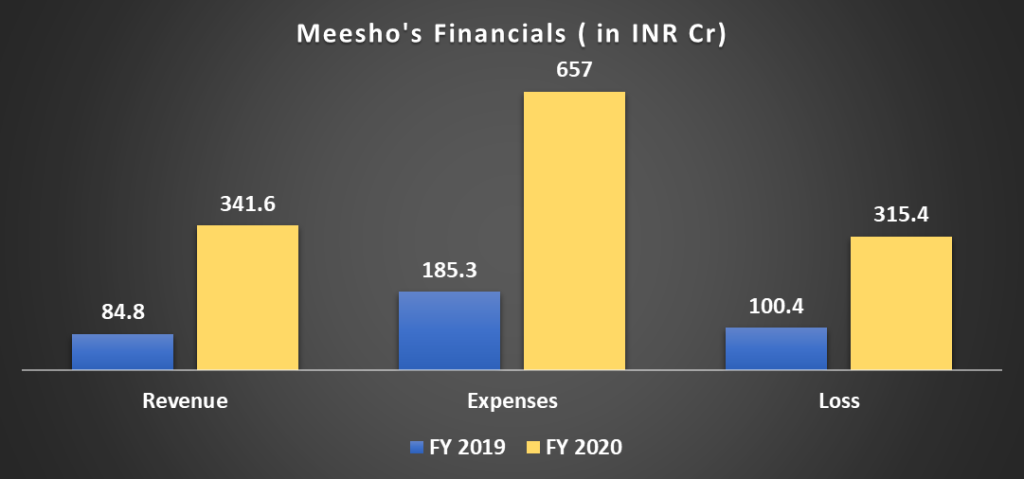On coming across Meesho, one might think of it as yet another online shopping platform. However, in recent times, Meesho has positioned itself as one of the leading platforms for social commerce.
We’ve seen Meesho’s advertisements in many places, whether it’s on social media sites such as Facebook or on recommendations we may get from Google. We may also have seen our peers or acquaintances selling products or operating their businesses via Meesho.
In the last five years, social commerce has been booming in India. In fact, it is even expected that the number of consumers of social commerce may cross the 228 million mark by the end of 2022! Moreover, Meesho, one of the pioneers of social commerce in India, has reached the milestone of $1 Billion Valuation in just five years.
Backed by investors such as Facebook, Shunwei Capital, Venture Highway, and Softbank Vision 2, Meesho has also raised $300 Million with a valuation of 2.1 Billion.
So, how did Meesho emerge as a success story in the arena of social commerce and online retail? This article discusses Meesho’s business model and what gives this platform its unique value. We will also discuss how does Meesho makes money?
The Begining
Before discussing Meesho’s rise to popularity, let’s talk about the unorganized retail sector in India. According to Statista, the Indian Retail Industry continues to be dominated by the unorganized sector, with a market share of 88% in 2019. While other E-Retail and Organised retail sectors have noted positive growth in their market share, the unorganized retail markets continue to remain popular amongst most consumers in India.
For centuries, unorganized retail stores, such as Kirana shops, vendors, and other small local businesses, have been integral to the Indian marketplace. Even after the advent of e-commerce shopping platforms such as Swiggy and Myntra, we are still accustomed to the hustle and bustle of local marketplaces for our retail needs.
This is how the founders Sanjeev Barnwal and Vidit Aatrey began ideating for their startup in 2015; back then, it was named “FashNear.” At first, they focused on creating a hyperlocal platform for fashion and retail, connecting local vendors to consumers online; they called it “Swiggy for Fashion.”
The founders then mapped stores around localities and allowed users to try on the clothes they’ve ordered, shortlist a few, and return the rest. However, after a few months, Barnwal and Aatrey figured out several challenges that came with the implementation of the idea and the logistics behind the model. During that time, social media platforms such as WhatsApp and Facebook grew prominent in the local marketplace.
If you were a frequent user of social media back in 2015 and 2016, you must’ve come across or been invited to groups where local sellers shared pictures of their new collection in stock to gauge consumer interest.
On seeing local stores leveraging social media to create a demand for their products, the founders realized one important aspect of bringing local marketplace online: social interactions and the relationship a buyer and seller share play a crucial role in strengthening consumer interest and product demand.
Aftermarket research and understanding consumer dynamics, FashNear was rechristened to Meesho, short for “Meri E-Shop” (My E-Shop), and became one of the first platforms in India that allowed local stores to create an online presence for their inventory and promote their shops through social channels.
Meesho’s business model soon garnered recognition among local stores and received fundings from various investors and accelerators. In 2016, it became one of the three Indian companies selected by Y-Combinator, a prestigious seed accelerator based in California, for a three-month program where it received $120,000. Not only that, Meesho became the first Indian platform to receive investment from Facebook and was reported to be India’s most downloaded app on the Play Store for July 2021.
What aspects of the business model make Meesho Unique?
The growth and success story of Meesho is quite an awe-inspiring one. In no time, Meesho became one of the most beloved platforms for local vendors and resellers, especially among those based in Tier 2 and Tier 3 cities in India. Meesho hosts more than 17 million resellers and 21,000 suppliers on its platform and continues to attract millions of customers.
But what makes Meesho unique as compared to other e-commerce and social commerce sites out there?
While other e-commerce giants such as Amazon mainly allow consumers to buy directly from sellers, Meesho emphasizes the reseller model. In simple words, the reseller model is a third party present between the buyer and the seller, i.e., the merchant.
Now, you may be wondering: How exactly does that make Meesho unique? Suppose you wish to start an online or a retail business of your own. With the reseller model as an option, you don’t have to go out of the way to brainstorm a unique product idea, do thorough market research beforehand, or even spend all your resources on product development and logistics! All you have to do is acquire the inventory from suppliers, promote it, and sell the products for higher profits.
Taking this idea forward, Meesho allowed such resellers to upload their inventory, manage orders and transactions, and promote their inventory on social channels. Suppose anyone wishes to purchase a product from the reseller. In that case, they do so via Meesho – here, the supplier saves money on logistics, the reseller earns their markup on the inventory, and Meesho earns commission from the supplier, creating a win-win situation for all parties involved.
Not only has Meesho brought the social aspect of the Indian local marketplace online, but the platform has also created an opportunity for women to become independent and earn household income. With the simple reseller model, Meesho made it easier for thousands of aspiring entrepreneurs and independent-earners to take a step towards establishing their own business as well as income. In this way, Meesho created higher trust among consumers and those who do their business from the platform.
The reseller model is not the only idea differentiating Meesho from other e-commerce platforms such as Amazon and Flipkart. Go through the products available on the platform. You’d find some of the most affordable prices, along with high-purchase frequency (that is, the number of times a customer buys from an e-shop in a given period.) and a variety of unbranded and local products. Moreover, Meesho has built an easy-to-use and accessible platform, made simple for resellers and suppliers to have a smooth process while managing their online business.
Meesho’s products come from various categories, mainly fashion, beauty, jewelry, home and kitchen goods, and electronics. Over time, they’ve even expanded to other areas, such as kids’ toys, accessories, and footwear.
What further fuelled Meesho’s rise in the e-commerce arena is its targeted focus on smaller regions and cities in India. By making online shopping easily accessible and readily available, Meesho has created a stronghold in these regions compared to other e-commerce giants that mainly focus on metropolitan cities.
Meesho recorded a revenue of INR 341.6 Cr in FY20, ending March 31, 2020, representing a 4X spike from the INR 84.8 Cr revenue in 2019. In the same period, the company’s expenses grew 3.5X to INR 657 Cr, leading to a loss of INR 315.4 Cr in the year, up from INR 100.42 Cr. Meesho spent INR 185.3 Cr in FY19, which is 15.8x the INR 10.97 Cr it spent in FY18.
Meesho’s Marketing Strategy
By now, we know about Meesho’s growth structure, its unique selling point, as well as its business model. Now, let’s understand Meesho’s marketing strategy. The platform has highly focused on its target consumers and has used marketing to connect to the audience’s higher aspirations and emotions.
Here are some examples of Meesho’s marketing campaigns
Defying All Odds!: Mission Rise
In 2019, Meesho organized Mission Rise – an exclusive women entrepreneurship summit. To give a platform for those who made an independent living for themselves, Mission Rise brought together more than 100 such successful women entrepreneurs to share business tips, tell about their stories and struggle, and inspire others to take a step ahead.
Sahi Sahi Lagaya Hai
If there is something that binds us, consumers, in India together, it is our preference to get the most value out of every purchase we make. Many times, we even find ourselves negotiating with local vendors about the right value for the product we purchase – frequently using the phrase “sahi sahi lagao na!” (quote the right price).
Ahead of the festive season this year, Meesho launched the campaign “Sahi Sahi lagaya hai!” to create an appeal to value-seeking consumers. The core concept of the campaign revolves around reassuring the customers that the products on Meesho are rightly priced and putting an end to the hassles of exploring local markets for hours and hours to find the best product at the best price possible. Here, the focus is not on the “lesser” price or the “higher” price but on the “right” value for every product purchased from Meesho.
My Store My Identity
In one of their first television campaigns, Meesho pays an ode to Indian women who have overcome social and economic barriers to create an identity for themselves. The film conveys that while a woman may have many names (such as Bahu, Beti, or Amma), she has one identity – of her own.
Something common in Meesho’s marketing campaigns and strategies is the key attributes they emphasize, such as inspiring women entrepreneurs and independent earners, showing how easy it is to navigate through the platform, and enabling local businesses to create an online presence of their own.
Through such marketing strategies, Meesho has created an appeal for audiences living in Tier 2+ cities who aspire to create independent living and get the best products at the most affordable rates.
Lessons to Learn from Meesho’s success
One of Meesho’s growth characteristics as one of the freshest unicorns in India is that the founders didn’t come up with something “out-of-the-world” or “extraordinary.” Instead, they focused on bringing a similar model of e-commerce to smaller regions in India and making these models more accessible to the users from these regions. Moreover, they integrated social interactions and relation-building between buyers and sellers through their platform.
An important takeaway from Meesho’s business model is to have a consumer-centric focus on profits and sales and create an incentive for more suppliers and resellers to join the platform and create a fortune of their own.
Social commerce heavily emphasizes the commerce and conversion aspects of sales and the consumer’s voice, the level of convenience, and the personalized shopping experiences.
-AMAZONPOLLY-ONLYWORDS-START-
Also, check out our most loved stories below

Why did Michelin, a tire company, decide to rate restaurants?
Is ‘Michelin Star’ by the same Michelin that sells tires, yes, it is! But Why? How a tire company evaluations became most coveted in the culinary industry?

Starbucks prices products on value not cost. Why?
In value-based pricing, products are priced based on the perceived value instead of cost. Starbucks has mastered the art of value-based pricing. How?

Nike doesn’t sell shoes. It sells an idea!!
Nike has built one of the most powerful brands in the world through its benefit-based marketing strategy. What is this strategy and how Nike has used it?

Domino’s is not a pizza delivery company. What is it then?
How one step towards digital transformation completely changed the brand perception of Domino’s from a pizza delivery company to a technology company?

Why does Tesla’s Zero Dollar Budget Marketing Strategy work?
Touted as the most valuable car company in the world, Tesla firmly sticks to its zero-dollar marketing. Then what is Tesla’s marketing strategy?

Yahoo! The story of strategic mistakes
Yahoo’s story or case study is full of strategic mistakes. From wrong to missed acquisitions, wrong CEOs, the list is endless. No matter how great the product was!!

Apple – A Unique Take on Social Media Strategy
Apple’s social media strategy is extremely unusual. In this piece, we connect Apple’s unique and successful take on social media to its core values.
-AMAZONPOLLY-ONLYWORDS-END-

















